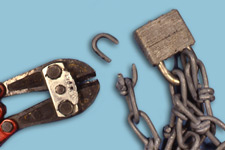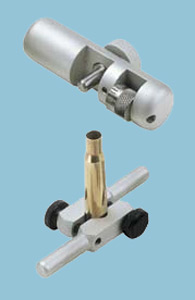Home | Glossary | Resources | Help | Contact Us | Course Map
Archival Notice
This is an archive page that is no longer being updated. It may contain outdated information and links may no longer function as originally intended.
Basic Toolmark Identification
Toolmark identification is a forensic science discipline that has as its primary concern the determination of whether or not a toolmark was produced by a particular tool. This determination is based on the class and individual marks in a given toolmark, which are products of the manufacturing process.
The main difference between firearms and toolmark identification is that the relative orientations of the harder object and the softer object in firearms examinations are easily predictable, while in the typical toolmark matter this is often not the case.
Incidental Toolmarks
Incidental marks are transferred by the operating surface of a tool making contact with the surface of a softer object. While class characteristics are planned by the manufacturer (e.g., width, shape, length), incidental marks (individual characteristics) are not planned and occur as a result of the manufacturing process as well as normal use of the tool.
These marks are as follows:
- Striated toolmarks (also called striae, friction marks, abrasion marks, or scratch marks) produced when a tool is placed against another object and moved parallel to and across the object with pressure applied. The striations consist of the resulting surface contour variations.
- Impressed toolmarks (also called compression marks) produced when a tool is placed against another object and sufficient force is applied to the tool to leave an impression. These impressions are contour variations left on the surface of the object by this interaction.
Both impressed and striated toolmarks may be produced by objects designed, manufactured, and marketed as task-specific tools or such tools misused for another purpose. Marks may be produced by other objects used as tools to gain a temporary mechanical advantage.
Reloading and Handloading
The processes involved in reloading and handloading ammunition produce toolmarks of a specialized type on ammunition components. In reloaded ammunition the marks are not the result of the discharge of a firearm. The action of the steel tools of a reloading press on the softer components of metallic ammunition may produce striated or impressed marks that can reflect class, subclass, and individual characteristics. The marks may potentially be reproduced, compared, and identified with a particular reloading tool.
The process of identification of toolmarks produced by reloading tools is parallel to other toolmark identifications in that they include the following:
- Characteristics that may be class, subclass, or individual
- Pattern identification
- AFTE Theory of Identification as it Relates to Toolmarks
- Principle of sufficient agreement
- Principle of consecutive matching striae
- AFTE Range of Conclusions
In general, the most useful toolmarks produced by reloading equipment fall into two categories:
- Cartridge case marks
- Holding tools on a reloading press which grips the base of cartridge cases
- Resizing tools (e.g., sizing die) which squeeze fired cases back to their original specifications
- Crimping tools used for some loads to press the mouth of cases slightly into a cannelure used as a crimping groove
- Bullets bearing bullet-seating toolmarks
Additional Online Courses
- What Every First Responding Officer Should Know About DNA Evidence
- Collecting DNA Evidence at Property Crime Scenes
- DNA – A Prosecutor’s Practice Notebook
- Crime Scene and DNA Basics
- Laboratory Safety Programs
- DNA Amplification
- Population Genetics and Statistics
- Non-STR DNA Markers: SNPs, Y-STRs, LCN and mtDNA
- Firearms Examiner Training
- Forensic DNA Education for Law Enforcement Decisionmakers
- What Every Investigator and Evidence Technician Should Know About DNA Evidence
- Principles of Forensic DNA for Officers of the Court
- Law 101: Legal Guide for the Forensic Expert
- Laboratory Orientation and Testing of Body Fluids and Tissues
- DNA Extraction and Quantitation
- STR Data Analysis and Interpretation
- Communication Skills, Report Writing, and Courtroom Testimony
- Español for Law Enforcement
- Amplified DNA Product Separation for Forensic Analysts





